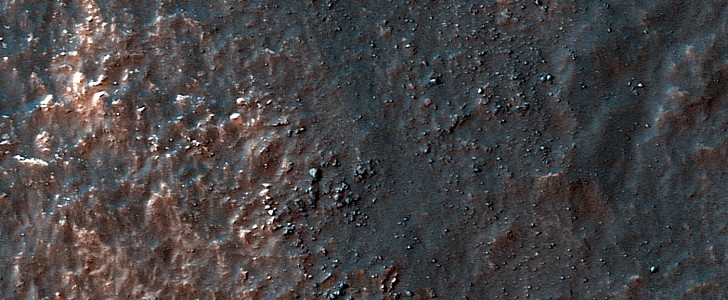Do you know that habit we humans have of throwing stones and pebbles into bodies of water, just to see them sink or skid? Well, something similar seems to be happening over on Mars, only the pebbles are large boulders, and the body of water is not all that easy to find.
The main image of this piece may not tell you much, but according to scientists over at the University of Arizona, who usually study pics of Mars, it shows an unusual concentration of boulders. We don’t know exactly what phenomenon is responsible for bringing these pieces of rock in these specific locations, but the very scientific theory is that it must be… “some interesting process.”
In relatively close proximity to these things lies the Hale Crater, a 150 km by 125 km (93 by 78 miles) remnant of an ancient impact with an asteroid some 35 km (22 miles) across, a place NASA believes might occasionally be home to liquid water. Not rivers or lakes of the stuff, but flows large enough for traces of them to be detected from high-up into orbit by the HiRISE camera.
Back in 2015, NASA said it believes this is so because it had detected something called recurring slope lineae, active flows of the warm side of slopes. These may have been caused by seeping water, which could be kept in liquid form by the high contents of salt lowering its freezing point.
The presence of liquid water on Mars, although not directly observed to this point, is crucial for plans of colonizing the planet. It would also be an even stronger indicator of the place having harbored life at one point in its past, and could even lead some to believe life in some form or another could be present there in our time.
In relatively close proximity to these things lies the Hale Crater, a 150 km by 125 km (93 by 78 miles) remnant of an ancient impact with an asteroid some 35 km (22 miles) across, a place NASA believes might occasionally be home to liquid water. Not rivers or lakes of the stuff, but flows large enough for traces of them to be detected from high-up into orbit by the HiRISE camera.
Back in 2015, NASA said it believes this is so because it had detected something called recurring slope lineae, active flows of the warm side of slopes. These may have been caused by seeping water, which could be kept in liquid form by the high contents of salt lowering its freezing point.
The presence of liquid water on Mars, although not directly observed to this point, is crucial for plans of colonizing the planet. It would also be an even stronger indicator of the place having harbored life at one point in its past, and could even lead some to believe life in some form or another could be present there in our time.






